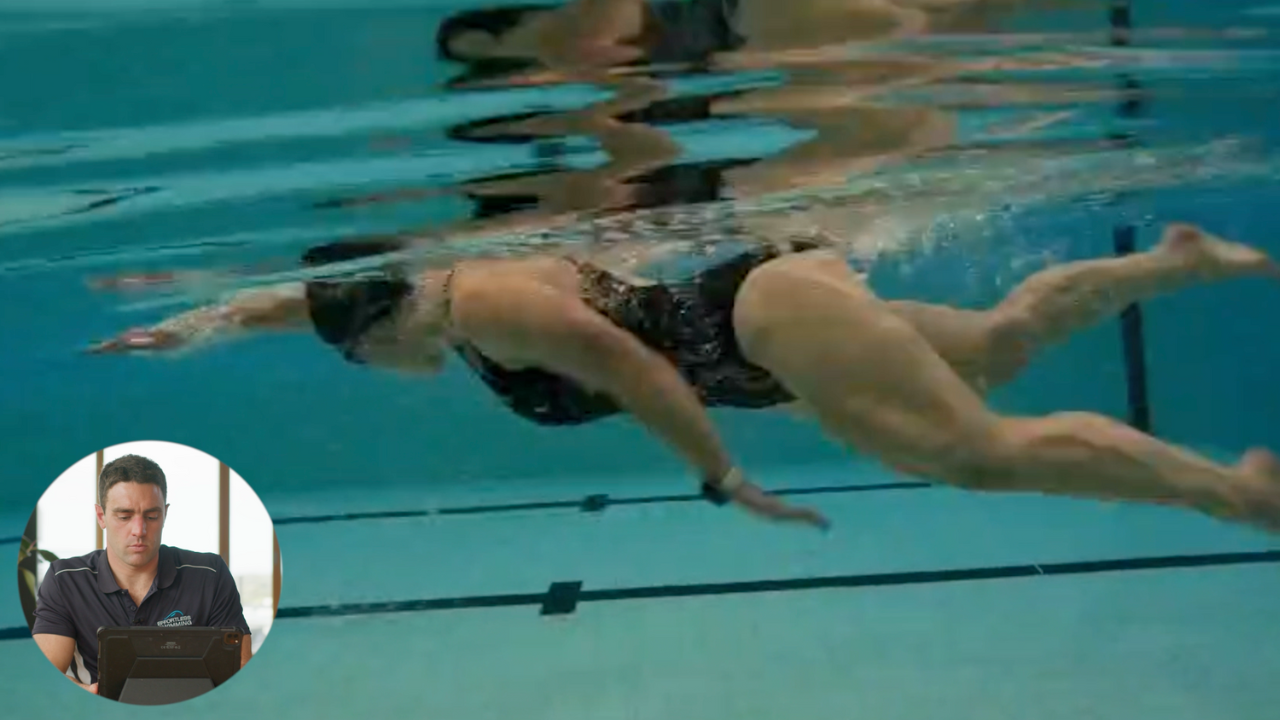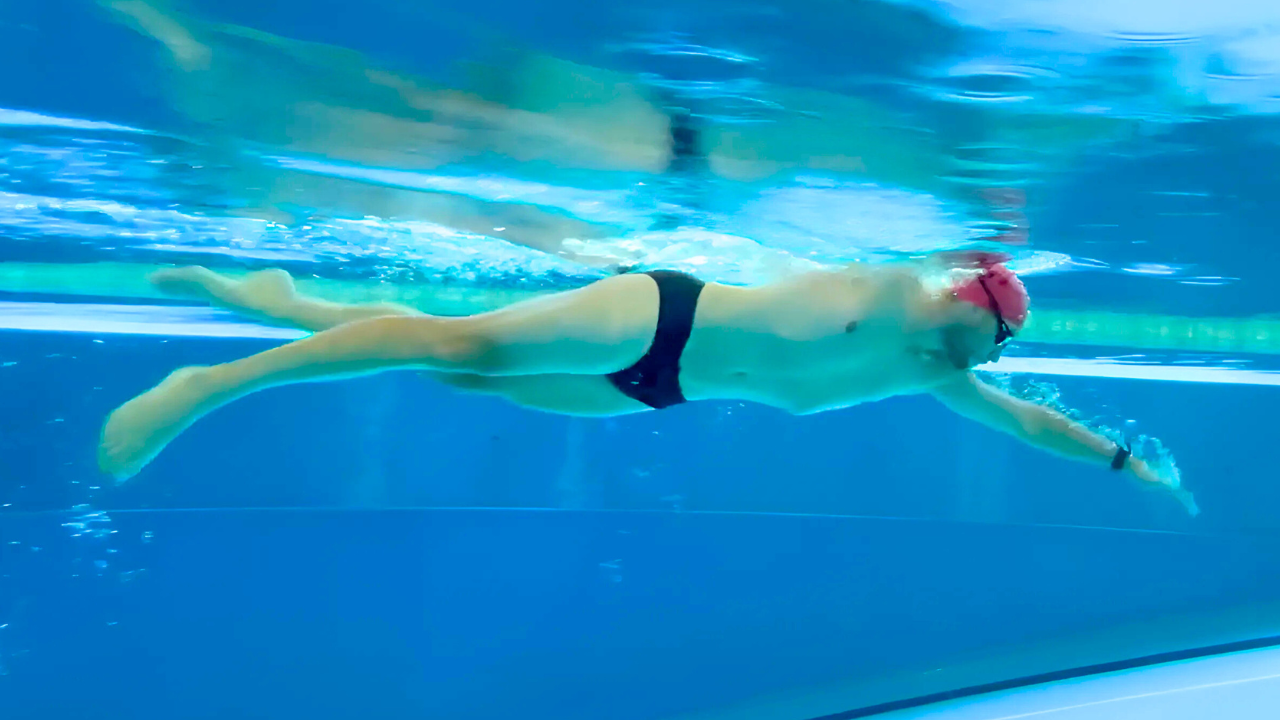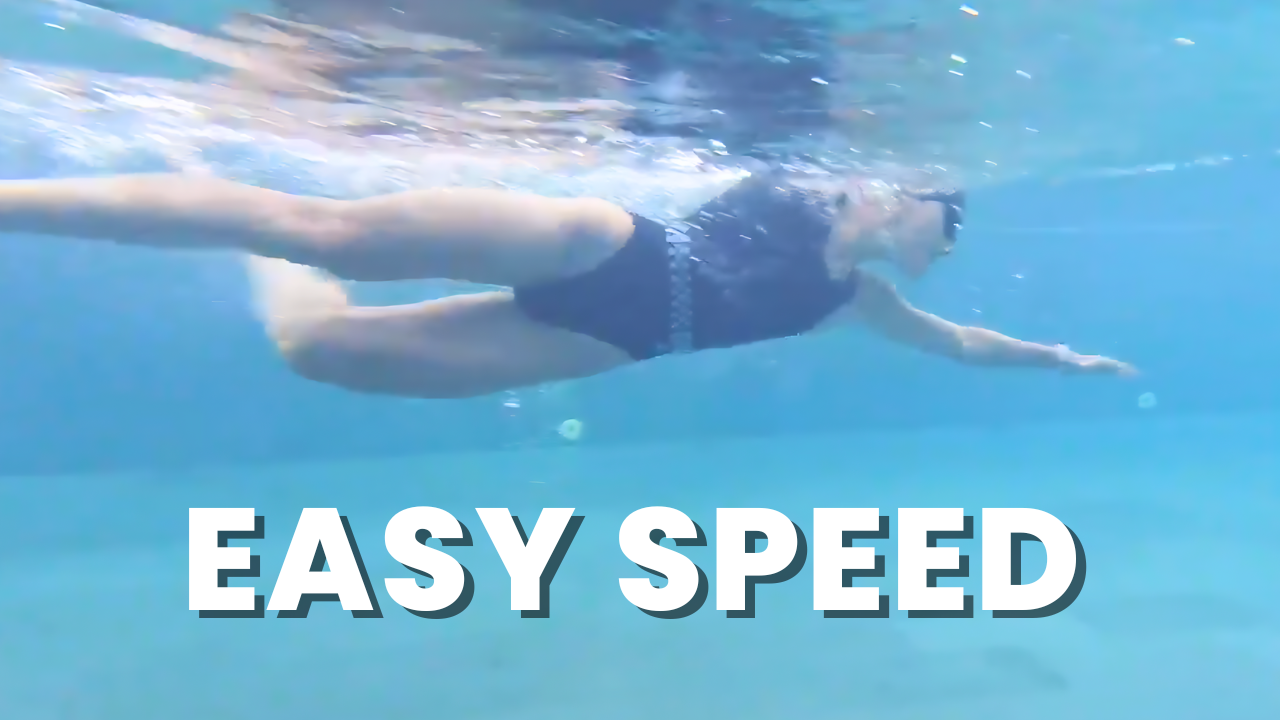Currently swimming at 1:50/100m, I believe this swimmer could adjust a few small things about her stroke to bring it down to 1:40 within a few weeks.
Transcription:
Welcome to Feedback Friday, where we analyze someone’s stroke and we look at what they can do to swim faster. In this episode, we’ve got a swimmer that is around the 150 pace per hundred. And you might be surprised at how simple some of the changes can be that I think will get it down to a low 140 at least in the next couple of weeks.
Now, it doesn’t mean that it’s easy to do. But some of the changes that she can make I think are quite simple. So the first thing I like to look at is the breathing. How is she breathing in and how is she exhaling? The exhalation looks good. You can see it’s coming primarily from the nose. Light exhale when her face is in the water. Then as she turns her head to breathe, we’ve got a bigger, more forceful exhale, which is good. So no need to change that. With the breathing, at times, she does turn the head a little bit too far. So when we look from above the water, we want to look at where are the eyes looking. And you’ll see here the eyes are probably just looking up a little bit high and the heads slightly lifted. So what she could aim to do there is just look more to the side and try and avoid lifting the head up too much.
But I think some of that will actually change with the head position when she’s swimming. So when we do look at the head position here, you’ll notice that it moves around quite a bit. It goes to the left and then it goes to the right there. The head’s the steering wheel for the rest of the body. So if the head’s moving side to side or up and down too much, typically the body will follow behind it. We generally want to keep the head stable and still because that’s going to keep the rest of the body much better aligned. So what I’d be aiming to do here is fix the vision. Look in the same spot, whether that be 40 to 45 degrees in front. There’s nothing wrong with that, especially if this person’s a triathlete or open water swimmer. As you know from our other videos, if you’ve subscribed to the channel for a while, there’s nothing wrong with looking slightly forward as long as you keep your neck long and extended, keep the top of the head out of the water. That’s best for most people.
So I’d recommend looking slightly in front, keep that neck long and avoid the head shifting to the left and then to the right. Just keep looking downwards. Now the thing that will probably happen when she does that is we’ll get rid of some of this arch through the lower back. So you still want a natural curve through the back. But we don’t want too much of an arch because if there is too much of an arch through that lower back like you can see here, it’s very hard to keep that tautness through the core and connect up the catch all the way through the body with the hip rotation and with the kick because there’s too much of a curve there.
So to have a better connection through the stroke, we’ve got to keep this a little bit flatter and that will probably come from a better head position, not looking too far forwards and keeping the eyes looking a little bit more downwards and avoid that left-to-right sway. After that, and that will probably take two or three weeks of some consistent practice and consistent to do it. It’s one of those things that can be very easy to change. The hardest part is remembering to do it every time that you swim because as soon as you don’t think about it you’ll just go back to what you’re used to doing. And it can take quite a few weeks of practice to change that. But that’s probably where I’d look to start. After that, I’d be looking to adjust the entry position. You can see on both hands how she comes over here, possibly a little bit wide with the recovery. So you might even start with the recovery.
So when the arm comes over the top, that’s what we call the arm recovery. And there’s nothing wrong with being out somewhat wide with the hand, but we don’t want to be too wide with it, where you’re coming over super low to the water and you’re not really getting this shoulder out of the water. Let’s have a look at the right one. Yeah, the shoulder can come out a little bit more and one of the things that I normally talk about at clinics is as a coach, if we’re looking from the side, I should be able to see your underarm, which you can actually see there, which is good. Might just be able to see it there. So, that’s all right from the side. But looking from the front she may be able to just get the shoulders, the arms, up just a little bit more out of the water.
But the key thing here will be where she enters. What we want to do the swim on train tracks. So if you imagine that you’ve got these train tracks that run in line with your shoulders, every time your hand enters the water, the hands should follow those train tracks in line with the shoulders there or in line with the ears. You’ll see that hand comes across the center, the left one does a similar thing comes over and see what happens on the stroke before that. A similar thing just crosses over the center. So at the moment, that’s probably partly why the head’s going side to side is that crossover at the start. So for her to be able to enter in line with the shoulder and extend straightforward, she’s going to have to make that hand entry feel very wide compared to what she’s used to doing and it can even pay to just look forward every now and then.
Check where the hands are going in. Check if you’re keeping that reach and extension straight out in front of you and just make the adjustment as needed because it’s very hard to know if you’re in the right position with anything out in front of the head. For whatever reason, just the appropriate reception out in front there can be very hard to tell whether you are in the right position or not. So we’d look at getting on the train tracks there. After that, that might change what’s happening under the water, but I think one of the reasons that I’d be looking to get on those train tracks is because the first thing is as she enters and reaches forwards, we see the hands up a little bit too high for a little bit too long. So in that position where the hand is higher than the wrist, the wrist is higher than the elbow, which increases the drag a lot.
Same on this left-hand side. There comes up and you can just see how that elbows in that drop position and it’s increasing the drag. Now the really common thing that we see when we’re coaching people at clinics and camps and when people send their videos online for coaching is that if you are crossing over that hands probably going to come upwards there, probably half the time. The reason for that is it’s a more comfortable position for the shoulder to be in to just let that hand be up in that position there. So often we find that when you do enter wider and you get on those train tracks, it’s much easier to get to the ideal starting catch position, which his fingers just below the wrists, wrists below the elbow. We want to see the fingertips about underarm depth. That’s where we should ideally be.
The reason that’s the best position is, first of all, it’s going to be a lot less drag. And secondly, that’s where you want to start the catch because then you’ve got the most room to set yourself up and you’re creating the least amount of drag. So that’s what I’ve been looking to do. Now there’s a really good chance that when she comes out wider, she’s on those train tracks, she’ll probably have to feel like the hand is down very deep. So for her to get the hand in that position early on, she might need to actually aim for that position because, again, you’ve got to exaggerate the things that happen out in front of the head to change them. That’s for most people. Then after that, where I can find the biggest increase in speed, in distance per stroke, will come from what happens through the catch and through the pool and press phase.
Now, we don’t have a front-on view but my guess is she’s finishing quite wide of the body through the press space. So from here back to the hip, I think that hand is quite wide. The same thing happens on the left-hand side. So I think she’s quite wide there and through the catch phase, I don’t think she’s going quite deep enough. So from there to there, you’ll see that position, the fingers are pointing down. That’s quite a good position with the hand and forearm, but she’s very shallow. That elbow is sort of very close to the water and when you’re that shallow in the water, very hard to be strong and effective and get much leverage from that arm. So I would encourage her when she’s in this position, make it feel like you’re going quite deep because of the path that the hands should take if we were to trace the fingertips, it should be like a quarter of a circle as she moves through that part of the stroke.
So maybe not that deep how I’ve drawn it. But from there to there you’ll see the path that it takes. It takes this path like that. Now it’s got to be a quarter of a circle. That’s where you see the best swimmers moving through in that catch movement. So it’s not like we want to go here and start pulling back immediately because there’s just not much power in that position. So she’ll probably have to make that feel very, very deep. And I was doing a similar thing a couple of years ago when I first got filmed. And when I was actually in the right position, it felt like I was pulling straight, pulling down really deep with the arm. But as a matter of fact, I was just in a much better position even though it felt like I was straight with the arm there. So that’s what she’ll probably have to do.
And then through the last part of the stroke she goes through here, she’ll probably have to feel like she’s coming in even under the body. I’ll see if I can find a better view. Yep. Here we go. So as we go from here, so we do a good job of getting those fingers pointing down. Just need to go a little bit deeper. Probably drifting out a bit wide from there to there because it looks like the hand is wider than the elbow. That’s got to stay on the inside of the elbow and then through this back part, this will make a huge difference from here to here. You’ll notice that the hand is out very wide from the hip at the exit. I’ve been working on this with a lot of swimmers in our membership lately who have been sending in videos. One of the things that I’ve noticed is through the last half of the pool from there to there, the hands are finishing really wide and for you to get much propulsion from that back part, it’s not really going to happen when you’re out that wide.
So in this position here, what I would encourage her to do is feel like you’re coming in very close to the center of the body on that insweep. So from there, the hand can even sort of turn in at almost 45 degrees for a moment to get in for that insweep so that then the upper arm and the ribs, that angle, that gap is closed and then this hand is finishing a lot closer to the hip. And it will feel like when she’s making that change, that she’s coming in very, very narrow. Even crossing the center under the body. That’s what it will feel like. But, she’ll get so much more out of each stroke that she’s taking there. I was working with someone at a session last week doing a similar thing, finishing too wide from the hip. So you’ve got to exaggerate the insweep from here to here and her stroke rate for 50 meters came down around 10% and it’s pretty common if you are finishing wide.
Stroke count came down 10%. What that better stroke count indicates is she’s just getting more distance per stroke. So, that’s a good thing. That’s what we want. So, that’s the order that I look to focus those things on. In terms of how do we change it? Well drills, if we have a look at the drills here, so you want to work on that head position. Great way to practice it can be kicking with your arms by your side with a snorkel on, put fins on if you like, but kicking face down and just rotating side to side. Keep the head in exactly the same spot and you’re just getting the hips and the upper body to rotate side to side while you’re keeping the vision fixed. Then after that, if we want to look at working on the alignment, well we’d probably go through our front kick, sidekick, and six-one-six drills.
That’s normally the oil that we follow at clinics. That’s what we often recommend in our fault fixer section in the video membership. And then after that, looking to work on the catch and pull. I would probably just go with a really simple one to work on this and it would be single arm freestyle with one arm in front and when you go through that one arm drill, we know we want to exaggerate that insweep as it comes closer to the hip. So, that’s a really easy way to do it. We know that we want to go deeper through the catch because you can see where she’s going quite shallow with it. The hands really angled off to the side. By going deeper and not coming out as wide, it will be a bit more fatiguing. It will be a bit more tiring, particularly through the lats cause that’s what she’ll be starting to use a lot more.
But over the course of four, five, six weeks, she’ll build up that strength and it’s going to be a much more effective and much faster stroke. And that’s why I think it can be fairly simple to bring the times down to probably that low 140’s for the same effort by making those changes. Now, it doesn’t mean those changes are necessarily easy to make. It takes a lot of concentration and focus and it takes time to change those habits. But by going through that order, with those sorts of drills, over time it will certainly get down there and there’s no reason why it couldn’t be somewhere in the 130’s. So, that’s the order that we’d probably go through in order to change a stroke. Thanks very much for watching. If you haven’t subscribed yet, click subscribe and hit the notification bell to get notified every time we upload another video.
We do these feedback Fridays pretty much on a weekly basis. And we also add one or two other videos each week, and if you would like to work with us, we run clinics in Australia and we have camps in Thailand, Hawaii, and in Queensland. And if you can’t get to any of those, then what a lot of swimmers do is send their videos to us for analysis and coaching. So you can do that through our video membership if you have a look at the stroke analysis section. I’ll put links to all of those below. Thanks very much for watching and I’ll see you next week.










